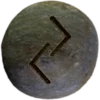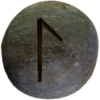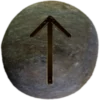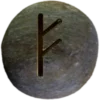Last Updated on February 22, 2025



Origins and Meaning
The Berkanan rune (ᛒ) (pronounced, “Ber-kan-ahn“) represents birth, growth, and renewal. It belongs to the Elder Futhark runic alphabet, the oldest runic system used by Germanic tribes. The rune’s shape resembles a tree or a mother’s breasts, emphasizing fertility, nurturing, and the cycles of life. Other Spellings include, Berkana and Bjarkan.
Scholars associate Berkanan with feminine energy, protection, and healing. Its name connects to the birch tree, which symbolizes resilience and purification. Birch trees grow fast and thrive in difficult conditions, making them a powerful metaphor for renewal. Many ancient cultures viewed the birch as sacred.
Berkanan appears in multiple rune poems. The Old Norwegian Rune Poem describes it as “leafy birch, small yet sheltering.” The Old Icelandic Rune Poem calls it “birch, without fruit yet useful.” These verses highlight its nurturing qualities, even though the tree does not bear edible fruit.
The Role of Berkanan in Growth and Healing
People used the Berkanan rune in charms for fertility, childbirth, and protection. Midwives and healers invoked it for safe deliveries. Many ancient cultures associated birth with divine forces. The rune’s connection to the birch tree further reinforced its role in purification rituals.
It also played a role in personal growth. It represented both literal and symbolic beginnings, guiding individuals through transformation. Warriors and travelers carried it for protection during journeys. It encouraged resilience, helping people navigate life’s challenges with strength and grace.
Magical inscriptions often paired Berkanan with other runes to amplify its power. When combined with Algiz (ᛉ), it enhanced protection. When paired with Laguz (ᛚ), it strengthened intuition and emotional healing. Such combinations showed the rune’s adaptability in different spiritual practices.
Berkanan in Mythology and Runescripts
The rune does not appear directly in the Poetic Edda or Prose Edda, but its themes align with various Norse myths. The goddess Frigg, known for her nurturing nature, embodies Berkanan’s energy. She protects children and ensures the continuation of life. ![]()
Some rune inscriptions from the Viking Age include Berkanan in fertility-related spells. Archeologists have found runic inscriptions on amulets, suggesting they played a role in protection rituals. In some cases, it marked burial sites, reinforcing its link to the life cycle.
In runescripts, it often appeared in bind runes. People carved these symbols on wood, bone, and metal to attract prosperity and healing. The rune’s shape made it ideal for blending with others, creating powerful magical sigils.
Its influence persists in modern runic studies. It remains a potent symbol of life, growth, and renewal. Those who study runes see it as a reminder to embrace change and nurture personal development.
Runes Associated with Berkanan
Laguz (ᛚ) (“Lah-gooz“) represents water, intuition, and emotional depth. This rune connects to Berkanan through themes of growth and nourishment. Water sustains life, just as Berkanan symbolizes fertility and renewal. Ancient people saw Laguz as a guide through life’s emotional currents. It also embodied adaptability, encouraging individuals to trust instincts and embrace change.
Healers used Laguz in rituals involving cleansing and emotional healing. People seeking inner clarity carved it onto amulets. When combined with Berkanan, it enhanced personal transformation and emotional balance. ![]()
Jēra (ᛃ) (“Yeh-rah“) symbolizes cycles, rewards, and patience. It represents the harvest, linking it to Berkanan’s themes of natural growth. Farmers used this rune to ensure a good yield. It reminded them that patience leads to abundance.
Berkanan and Jēra together reinforced steady progress. People relied on this pairing for fertility, prosperity, and long-term success.
Its Power in Asatru
Asatruar see Berkanan as a rune of new beginnings, healing, and fertility. It connects deeply to family, kinship, and personal growth. Many Asatruar use it in rituals honoring Frigg, Freyja, or Nerthus, deities linked to motherhood and renewal.
Blóts and personal meditations often include this rune when focusing on family protection or spiritual rebirth. Some Asatruar carve it onto amulets for fertility blessings or safe childbirth. It also represents inner strength, guiding individuals through emotional and spiritual transformations.
Berkanan supports community bonds within kindreds. It reminds Asatruar to nurture their relationships and protect their sacred spaces. Many include it in runic charms to strengthen unity and maintain harmony.
During seasonal festivals, it symbolizes the earth’s renewal. It appears in Ostara and Yule celebrations, reinforcing nature’s cycles. Asatruar honor this rune as a reminder of life’s continuous growth and rebirth.


